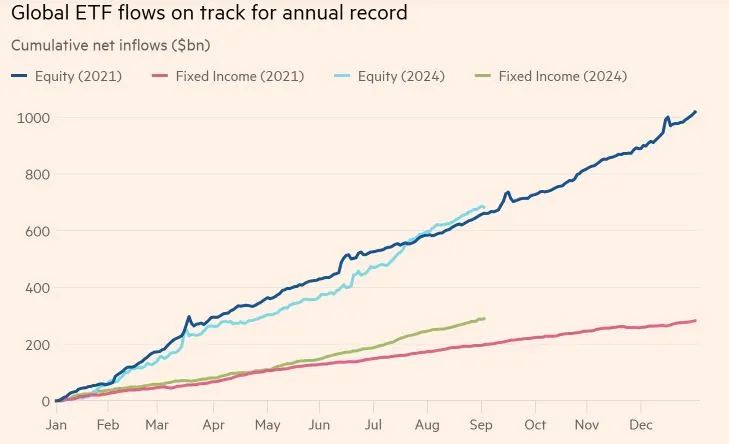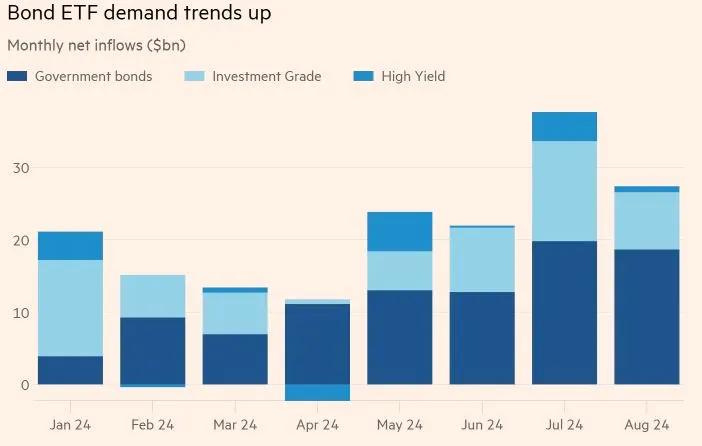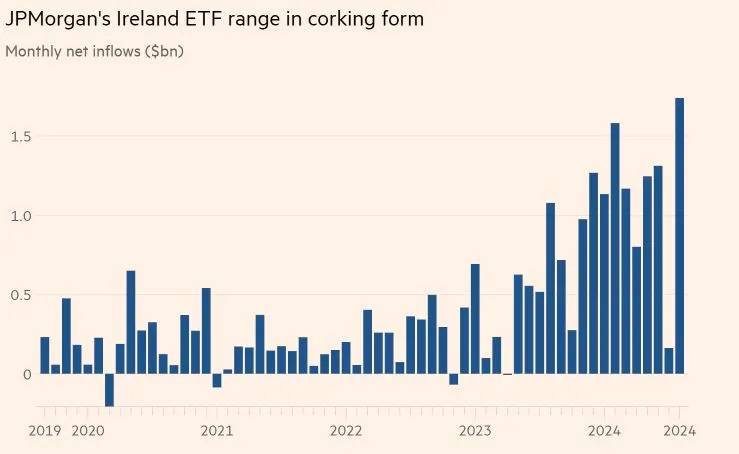Global ETF flows are set to break previous records as investors remain confident in the resilience of exchange-traded funds (ETFs). In 2024, despite market volatility and economic uncertainties, investors have poured billions into ETFs, indicating a strong belief in their long-term potential. Passive investing continues to dominate the landscape, providing investors with low-cost, diversified exposure to various asset classes. Fixed income ETFs and emerging market ETFs have been two key areas of growth, further driving the unprecedented surge in global ETF flows.
Record-Breaking ETF Inflows Amid Market Challenges

As of August, global ETF flows have reached a staggering $969 billion, already surpassing 2021’s figures for the same period. Despite a turbulent market environment characterized by sudden drops in major indices like the S&P 500, investors have continued to allocate significant funds to ETFs. The month of August alone saw a net inflow of $129.7 billion into ETFs, according to BlackRock data. This level of investment shows that global ETF flows are defying historical trends, which often see lower inflows during the summer months.
One key factor driving this record pace of inflows is the growing popularity of passive investing. Many investors have embraced ETFs as a cost-effective way to participate in the broader market without having to actively manage their portfolios. As a result, ETF flows have become more consistent, even during periods of market volatility. The automated nature of passive investing, along with regular contributions to retirement accounts, means that ETF inflows continue to grow regardless of short-term market fluctuations.
Strong Interest in Fixed Income ETFs
Fixed income ETFs have emerged as a significant contributor to global ETF flows in 2024. As central banks signal potential easing and interest rate cuts, demand for these funds has surged. Investors have channeled $288 billion into fixed income ETFs so far this year, far outpacing the $195 billion seen during the same period in the record-breaking year of 2021. This influx highlights the growing appeal of bond funds as a safer alternative in times of uncertainty.
Many investors see fixed income ETFs as a defensive strategy, particularly when equity markets experience sharp downturns. Government bond ETFs, often seen as the lowest risk option, attracted $18.7 billion in August alone. In contrast, high-yield bond ETFs saw more modest inflows of $0.8 billion, reflecting investor caution toward riskier assets. Investment-grade corporate bond funds also performed well, with inflows reaching $7.9 billion. The continued strength of fixed income ETFs is a testament to their role in providing stability amid market volatility.
Emerging Market ETFs: A Mixed Bag of Performance
While fixed income ETFs have thrived, emerging market ETFs have experienced a more complex journey. Global ETF flows to emerging markets have seen both significant inflows and outflows, depending on the region and specific economic conditions. For instance, investors withdrew $700 million from U.S.-domiciled emerging market ETFs in August, with China-focused ETFs seeing outflows of $1.3 billion. Over the past three months, China-focused ETFs have recorded $4 billion in outflows, marking their worst performance in 15 years.
Despite the challenges faced by China ETFs, global inflows into emerging market ETFs totaled $22 billion in August. This divergence in performance reflects varying investor sentiment toward different regions. Investors in China may have been discouraged by economic challenges and geopolitical tensions, while other emerging markets, such as India and Brazil, have presented more attractive investment opportunities.
This mixed performance demonstrates the importance of geographic diversification when investing in emerging market ETFs. While some countries may experience downturns, others offer growth potential, making it essential for investors to carefully assess regional dynamics.
The Resilience of Passive Investing
One of the most remarkable aspects of the record-breaking global ETF flows is the continued strength of passive investing. This investment strategy, which focuses on replicating the performance of a specific index or asset class, has become the dominant force in ETF markets. Investors increasingly favor passive investing due to its cost efficiency and ability to provide broad market exposure without the need for active management.
Even during periods of market volatility, passive investing strategies have maintained their appeal. Investors have largely shrugged off short-term fluctuations in favor of long-term growth prospects. For instance, despite a sharp 6% drop in the S&P 500 over just three trading days in August, ETF inflows remained robust. This resilience speaks to the growing confidence in passive investing as a reliable approach, even when market conditions are uncertain.
Defensive Sectors and “Buy on the Dip” Mentality
Another noteworthy trend driving global ETF flows is the focus on defensive sectors. In 2024, sectors such as financials, utilities, and healthcare have attracted significant investor attention. These sectors are typically considered less sensitive to economic cycles, making them attractive during times of market volatility. In particular, utilities and financials have seen strong inflows as investors seek to balance their exposure to more volatile sectors like technology.
The “buy on the dip” mentality has also contributed to the growth in global ETF flows. This investment approach involves purchasing assets during market downturns, with the expectation that prices will rebound. Many investors have adopted this strategy in response to market volatility, allowing them to capitalize on temporary declines in asset prices. In August, this mindset was particularly evident in the Japanese equity ETF market, where investors poured $2.5 billion into funds after three months of outflows totaling $8.7 billion.
Fixed Income Rebalancing and Investor Caution
While overall global ETF flows are surging, some investors remain cautious, particularly in the fixed income space. Much of the recent buying activity can be attributed to forced rebalancing by entities that follow a 60/40 equity/bond portfolio model. As equity markets have surged in recent months, these investors have had to shift a portion of their portfolios into fixed income ETFs to maintain their target allocation. This forced rebalancing has contributed to the significant inflows into bond funds.

At the same time, investors have shown a reluctance to take on excessive risk in fixed income markets. While government bond ETFs and investment-grade corporate bond funds have performed well, high-yield bonds and emerging market debt have seen weaker demand. This caution reflects broader concerns about the global economic outlook and the potential for further market disruptions.
Rising Demand for Safe Havens
In addition to fixed income ETFs, other traditional safe-haven assets have seen renewed interest. Gold ETFs, which had experienced outflows in previous months, have begun to attract more attention as market uncertainty persists. The price of gold has reached record highs in 2024, driven by concerns over inflation, geopolitical risks, and the potential for economic slowdowns in major economies.
The increased demand for gold ETFs highlights the ongoing desire for safe-haven assets during times of market volatility. Investors are looking for ways to protect their portfolios from potential downturns while still maintaining exposure to growth opportunities.
A Global Perspective on ETF Growth
The growth of global ETF flows is not confined to a single region or market. Investors around the world are contributing to the surge in ETF inflows, reflecting the widespread appeal of these investment vehicles. In Europe, for example, JPMorgan’s Ireland-domiciled ETF range recorded $1.7 billion in net inflows in August, led by its Global Research Enhanced Index Equity (ESG) UCITS ETF. This success underscores the increasing popularity of ESG (environmental, social, and governance) investments, which have become a significant theme in global markets.

Meanwhile, U.S.-domiciled ETFs continue to experience strong demand, with August inflows reaching $73 billion, more than twice the average for the month. The U.S. remains the largest market for ETFs, but international markets are playing an increasingly important role in driving global ETF flows. In particular, the rise of emerging market ETFs and the growing interest in ESG-focused funds are reshaping the global landscape.
Conclusion: Global ETF Flows on Track to Break Records
Global ETF flows are on course to shatter previous records in 2024, driven by investor confidence and a growing appetite for passive investing. Despite market volatility, ETFs have continued to attract significant inflows, particularly in the areas of fixed income and defensive equity sectors. Emerging market ETFs have seen mixed results, but the overall trend remains positive as investors seek diversified exposure to global markets. With demand for safe-haven assets rising and the resilience of passive investing strategies, the ETF market shows no signs of slowing down.
As we approach the end of the year, all signs point to a record-breaking year for global ETF flows. Whether through fixed income ETFs, emerging market ETFs, or defensive equity sectors, investors are demonstrating their confidence in ETFs as a cornerstone of modern portfolio management.
Click here to read our latest article Fiery Presidential Debate
This post is originally published on EDGE-FOREX.
